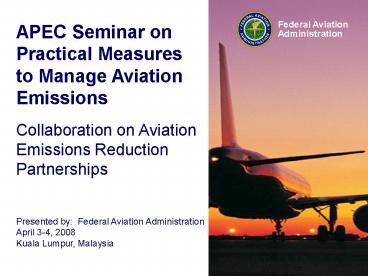APEC Seminar on Practical Measures to Manage Aviation Emissions - PowerPoint PPT Presentation
1 / 18
Title:
APEC Seminar on Practical Measures to Manage Aviation Emissions
Description:
... are requested route changes after an aircraft has begun its flight. ... DARPs allow the aircraft to switch to a Dynamic Reroute to maximize flight efficiency. – PowerPoint PPT presentation
Number of Views:105
Avg rating:3.0/5.0
Title: APEC Seminar on Practical Measures to Manage Aviation Emissions
1
APEC Seminar on Practical Measures to Manage
Aviation Emissions Collaboration on Aviation
Emissions Reduction Partnerships
Presented by Federal Aviation
Administration April 3-4, 2008 Kuala Lumpur,
Malaysia
2
Overview
- Global Aviation and the Environment
- Atlantic Interoperability Initiative to Reduce
Emissions (AIRE) - Asia and South Pacific Initiative to Reduce
Emissions (ASPIRE)
3
Global Aviation and the Environment
- The air transportation industry is essential for
future economic growth and development, as
aircraft carry approximately 40 of the value of
all world trade. - Last year 2.2 billion people flew on the worlds
airlines, more passengers than ever before, with
predictions of 9 billion passengers by 2025 - The United Nations Intergovernmental Panel on
Climate Change (IPCC) attributes nearly 3 of
global greenhouse gas emission (mostly from
carbon) to aviation - As global aviation continues to grow and become a
vital part of the worldwide economy, pressure to
address environmental impacts will increase
4
ICAO Strategic Objectives
- In Support of ICAOS Strategic Objectives
- Minimize the adverse effect of Global Civil
Aviation on the environment - Enhance the efficiency of aviation operations
5
AIRE Background
- Hasten development of operational procedures to
reduce aviations environmental foot print on a
gate-to-gate basis - Quantify environmental benefits to aid in
formulation of potential business cases
- Accelerate incorporation and worldwide
interoperability of procedures/standards - Capitalize on existing technology on either side
of Atlantic - Identify implementation issues, obstacles, choke
points, metrics and solutions
6
AIRE Domains
7
AIRE Progress to Date
- AIRE Agreement announced at Paris Air Show in
June 2007 - Initial FAA AIRE program plan published in
December 2007 - Continued planning on FY08 operational concept
demos to show reduced engine emissions - Continuous Descent Arrivals at Atlanta and Miami
(May 2008) - Tailored arrivals at Miami (May 2008)
- Surface enhancements at New York (JFK) and
Memphis (Sept 2008) - Oceanic enhancements in the Atlantic (Sept 2008)
8
2008 AIRE Oceanic Demo
Optimization Sequence
CDG
Coordination and Clearance Sequence
MIA
Sequences repeat at frequent interval (e.g. every
60 minutes)
9
Pacific Partnership
10
Asia and South Pacific Initiative to Reduce
Emissions (ASPIRE)
- After the launch of AIRE in June 2007, a
counterpart program in the Asia Pacific region
was envisioned to leverage the efforts of
existing North and South Pacific informal working
groups (IPACG and ISPACG) and encourage a
stronger focus on environmental benefits - This Asia Pacific program became known as the
Asia and South Pacific Initiative to Reduce
Emissions, or ASPIRE - High level statement on ASPIRE collaboration was
signed on February 18, 2008 in Singapore between
the FAA, Airservices Australia, and Airways New
Zealand. - Extended participation is needed and encouraged
from Asia Pacific ANSPs, airlines and industry in
order to fully progress operational emissions
reduction initiatives. - Initial ASPIRE efforts will focus on South
Pacific initiatives, with future expansion to the
North Pacific and the rest of the Asia Pacific
region.
11
ASPIRE Objectives
- Hasten development of operational procedures to
reduce aviations environmental foot print on a
gate-to-gate basis covering each stage of
airport operations surface, departure, en route,
arrival. - Accelerate incorporation and worldwide
interoperability of procedures/standards. - Capitalize on existing technology in place across
the Pacific. - Provide a systematic approach which combines a
set of short, medium, and long-term initiatives
to enhance environmental and efficiency
performance. - Better identify issues, obstacles, choke points,
metrics and solutions through cross-fertilization
of demonstrations, development and flight trials
in the Asia Pacific region.
12
ASPIRE Candidate Initiatives
- Performance Metrics
- User Preferred Route (UPR) Expansion
- Dynamic Airborne Reroute Programs (DARP)
- Tailored Arrivals
- End-to-End Demonstration
13
Performance Metrics
- Highest priority initiative projected under
ASPIRE - Metrics will catalog the efficiency and emissions
gains to date since the introduction of the
following South Pacific initiatives - Dynamic Airborne Reroute Program (DARP)
- User Preferred Routes (UPR)
- 30nm lateral/30nm longitudinal separation
- Goal is to formalize emission gains so far and to
create a common baseline for future work - Requires participation and data from all ASPIRE
partners
14
User Preferred Route (UPR) Expansion
15
Dynamic Airborne Reroute Programs (DARP)
16
Oceanic Tailored Arrivals
- Comprehensive trajectory based arrival clearance
to a coastal destination airport using FANS
Datalink
- Trials are underway at San Francisco
- Atlantic coastal trials planned for 2008
- Future implementation in coastal destinations
will be based on 2008 trials and analysis
17
End to End Demonstration
18
THANK YOU































